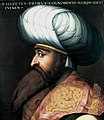
The Uffizi Gallery is a prominent art museum located adjacent to the Piazza della Signoria in the Historic Centre of Florence in the region of Tuscany, Italy. One of the most important Italian museums and the most visited, it is also one of the largest and best-known in the world and holds a collection of priceless works, particularly from the period of the Italian Renaissance.

ManuelChrysoloras was a Byzantine Greek classical scholar, humanist, philosopher, professor, and translator of ancient Greek texts during the Renaissance. Serving as the ambassador for the Byzantine emperor Manuel II Palaiologos in medieval Italy, he became a renowned teacher of Greek literature and history in the republics of Florence and Venice, and today he's widely regarded as a pioneer in the introduction of ancient Greek literature to Western Europe during the Late Middle Ages.

Cosimo I de' Medici was the second duke of Florence from 1537 until 1569, when he became the first grand duke of Tuscany, a title he held until his death.

Gian Francesco Poggio Bracciolini, usually referred to simply as Poggio Bracciolini, was an Italian scholar and an early Renaissance humanist. He is noted for rediscovering and recovering many classical Latin manuscripts, mostly decaying and forgotten in German, Swiss, and French monastic libraries. His most celebrated finds are De rerum natura, the only surviving work by Lucretius, De architectura by Vitruvius, lost orations by Cicero such as Pro Sexto Roscio, Quintilian's Institutio Oratoria, Statius' Silvae, and Silius Italicus's Punica, as well as works by several minor authors such as Frontinus' De aquaeductu, Ammianus Marcellinus' Res Gestae, Nonius Marcellus, Probus, Flavius Caper, and Eutyches.

Agnolo di Cosimo, usually known as Bronzino or Agnolo Bronzino, was an Italian Mannerist painter from Florence. His sobriquet, Bronzino, may refer to his relatively dark skin or reddish hair.

De Viris Illustribus, meaning "concerning illustrious men", represents a genre of literature which evolved during the Italian Renaissance in imitation of the exemplary literature of Ancient Rome. It inspired the widespread commissioning of groups of matching portraits of famous men from history to serve as moral role models.
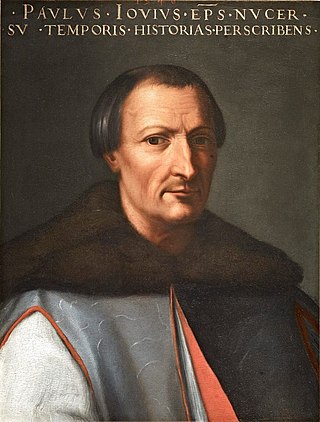
Paolo Giovio was an Italian physician, historian, biographer, and prelate.

The Pseudo-Seneca is a Roman bronze bust of the late 1st century BC that was discovered in the Villa of the Papyri at Herculaneum in 1754, the finest example of about two dozen examples depicting the same face. It was originally believed to depict Seneca the Younger, the notable Roman philosopher, because its emaciated features were supposed to reflect his Stoic philosophy. However, modern scholars agree it is likely a fictitious portrait, probably intended for either Hesiod or Aristophanes. It is thought that the original example was a lost Greek bronze of c. 200 BC. The bust is conserved in the Museo Archeologico Nazionale, Naples.
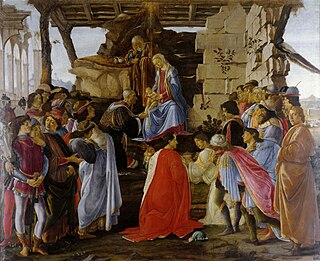
The Adoration of the Magi is a painting by the Italian Renaissance master Sandro Botticelli. Botticelli painted this piece for the altar in Gaspare di Zanobi del Lama's chapel in Santa Maria Novella around 1475. This painting depicts the Biblical story of the Three Magi following a star to find the newborn Jesus. The image of the altarpiece centers on the Virgin Mary and the newborn Jesus, with Saint Joseph behind them. Before them are the three kings who are described in the New Testament story of the Adoration of the Magi. The three kings worship the Christ Child and present him with gifts of gold, frankincense and myrrh. In addition, the Holy Family is surrounded by a group of people who came to see the child who was said to be the son of God.
Cristofano dell'Altissimo was an Italian painter in Florence.

Portrait of a Man with a Medal of Cosimo the Elder, also known as Portrait of a Youth with a Medal, is a tempera painting by Italian Renaissance painter Sandro Botticelli. The painting features a young man displaying in triangled hands a medal stamped with the likeness of Cosimo de' Medici. The identity of the young man has been a long-enduring mystery. Completed in approximately 1475, it is on display in the Uffizi Gallery of Florence.
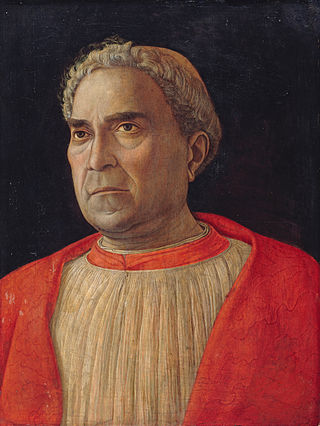
The Portrait of Cardinal Ludovico Trevisan is a painting by the Italian Renaissance artist Andrea Mantegna, dated to c. 1459-1460.

Primavera, is a large panel painting in tempera paint by the Italian Renaissance painter Sandro Botticelli made in the late 1470s or early 1480s. It has been described as "one of the most written about, and most controversial paintings in the world", and also "one of the most popular paintings in Western art".

The Lamentation of Christ is an oil-on-panel painting of the common subject of the Lamentation of Christ by the Netherlandish artist Rogier van der Weyden, dating from around 1460–1463 and now in the Uffizi Gallery, Florence, Italy.

The Portrait of Sir Richard Southwell is a painting by the German Renaissance master Hans Holbein the Younger, executed around 1536–1537. It is housed in the Uffizi, Florence.

Madonna with Child is a painting by the Italian Renaissance artist Filippo Lippi. The date in which it was executed is unknown, but most art historians agree that it was painted during the last part of Lippi's career, between 1450 and 1465. It is one of the few works by Lippi which was not executed with the help of his workshop and was an influential model for later depictions of the Madonna and Child, including those by Sandro Botticelli. The painting is housed in the Uffizi Gallery, Florence, Italy, and is therefore commonly called “The Uffizi Madonna” among art historians.
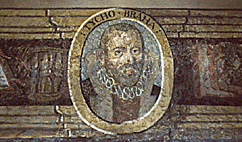
The painted frieze at the Bodleian Library, in Oxford, United Kingdom, is a series of 202 portrait heads in what is now the Upper Reading Room. It was made in 1619, and the choice of worthies to include was advanced for its time, featuring Copernicus and Paracelsus as well as Protestant reformers. The portraits have been attributed to the London guild painter Thomas Knight; they were taken from at least ten different sources, according to current views.

Portrait of a Knight of Malta is a c.1515 oil on canvas painting by Titian of a knight belonging to the Order of Malta. It is now in the Uffizi in Florence. The last bead of the rosary held by the knight bears the number XXXV (35), showing the subject's age at the time of the portrait. W.F. Dickes. argued that he was Stefano Colonna, the condottiero who led the republican resistance during the siege of Florence. cited in

Portrait of Cosimo the Elder is an oil on panel painting by Pontormo, executed c. 1519–1520, now in the Uffizi, Florence.

The Museums of Florence form a key element of the cultural and artistic character of the city. Of the 15 most visited Italian art museums and galleries, five are in Florence. The number and proximity of the works of art in the museums of Florence can trigger Stendhal syndrome on visitors who try to see them all, as evidenced by hospital records of hundreds of visitors each year affected by the syndrome. The art in Florence was one of the elements that contributed to the central part of the city being named a UNESCO World Heritage Site.


